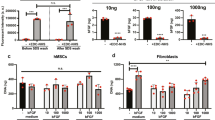Abstract
Growth of cells in tissue culture is generally performed on two-dimensional (2D) surfaces composed of polystyrene or glass. Recent work, however, has shown that such 2D cultures are incomplete and do not adequately represent the physical characteristics of native extracellular matrix (ECM)/basement membrane (BM), namely dimensionality, compliance, fibrillarity, and porosity. In the current study, a three-dimensional (3D) nanofibrillar surface composed of electrospun polyamide nanofibers was utilized to mimic the topology and physical structure of ECM/BM. Additional chemical cues were incorporated into the nanofibrillar matrix by coating the surfaces with fibronectin, collagen I, or laminin-1. Results from the current study show an enhanced response of primary mouse embryonic fibroblasts (MEFs) to culture on nanofibrillar surfaces with more dramatic changes in cell spreading and reorganization of the cytoskeleton than previously observed for established cell lines. In addition, the cells cultured on nanofibrillar and 2D surfaces exhibited differential responses to the specific ECM/BM coatings. The localization and activity of myosin II-B for MEFs cultured on nanofibers was also compared. A dynamic redistribution of myosin II-B was observed within membrane protrusions. This was previously described for cells associated with nanofibers composed of collagen I but not for cells attached to 2D surfaces coated with monomeric collagen. These results provide further evidence that nanofibrillar surfaces offer a significantly different environment for cells than 2D substrates.







Similar content being viewed by others
References
Kim BS, Nikolovski J, Bonadio J, Smiley E, Mooney DJ (1999) Engineered smooth muscle tissues: regulating cell phenotype with the scaffold. Exp Cell Res 251:318–328
Sakiyama SE, Schense JC, Hubbell JA (1999) Incorporation of heparin-binding peptides into fibrin gels enhances neurite extension: an example of designer matrices in tissue engineering. FASEB J 13:2214–2224
Lutolf MP, Lauer-Fields JL, Schmoekel HG, Metters AT, Weber FE, Fields GB, Hubbell JA (2003) Synthetic matrix metalloproteinase-sensitive hydrogels for the conduction of tissue regeneration: engineering cell-invasion characteristics. Proc Natl Acad Sci USA 100:5413–5418
Schmeichel KL, Bissell MJ (2003) Modeling tissue-specific signaling and organ function in three dimensions. J Cell Sci 116:2377–2388
Meiners S, Mercado ML (2003) Functional peptide sequences derived from extracellular matrix glycoproteins and their receptors: strategies to improve neuronal regeneration. Mol Neurobiol 27:177–196
Shin H, Jo S, Mikos AG (2003) Biomimetic materials for tissue engineering. Biomaterials 24:4353–4364
Cukierman E, Pankov R, Stevens DR, Yamada KM (2001) Taking cell-matrix adhesions to the third dimension. Science 294:1708–1712
Grinnell F, Ho CH, Tamariz E, Lee DJ, Skuta G (2003) Dendritic fibroblasts in three-dimensional collagen matrices. Mol Biol Cell 14:384–395
Cukierman E, Pankov R, Yamada KM (2002) Cell interactions with three-dimensional matrices. Curr Opin Cell Biol 14:633–639
Wozniak MA, Desai R, Solski PA, Der CJ, Keely PJ (2003) ROCK-generated contractility regulates breast epithelial cell differentiation in response to the physical properties of a three-dimensional collagen matrix. J Cell Biol 163:583–595
Schindler M, Ahmed I, Nur-E-Kamal A, Kamal J, Grafe TH, Chung HY, Meiners S (2005) Synthetic nanofibrillar matrix promotes in vivo-like organization and morphogenesis for cells in culture. Biomaterials 26:5624–5631
Chung HY, Hal JRB, Gogins MA, Crofoot DG, Weik TM (2004) Polymer, polymer microfiber, polymer nanofiber and applications including filter structures. US Patent No 6,743,273 B2
Li WJ, Danielson KG, Alexander PG, Tuan RS (2003) Biological response of chondrocytes cultured in three-dimensional nanofibrous poly(epsilon-caprolactone) scaffolds. J Biomed Mater Res 67A:1105–1114
Yoshimoto H, Shin YM, Terai H, Vacanti JP (2003) A biodegradable nanofiber scaffold by electrospinning and its potential for bone tissue engineering. Biomaterials 12:2077–2082
Boland ED, Matthews JA, Pawlowski KJ, Simpson DG, Wnek GE, Bowlin GL. Electrospinning collagen, elastin (2004) preliminary vascular tissue engineering. Front Biosci 9:1422–1432
Nur-E-Kamal A, Ahmed I, Kamal J, Schindler M, Meiners S (2005) Three dimensional nanofibrillar surfaces induce activation of Rac. Biochem Biophys Res Com 331:428–434
Ashkenas J, Muschler J, Bissell MJ (1996) The extracellular matrix in epithelial biology: shared molecules and common themes in distant phyla. Dev Biol 180:433–444
Kalluri R. (2003) Basement membranes: structure, assembly and role in tumour angiogenesis. Nat Rev Cancer 3:422–433
Kleinman HK, Philp D, Hoffman MP (2003) Role of the extracellular matrix in morphogenesis. Curr Op Biotech 14:526–532
Katz BZ, Zamir E, Bershadsky A, Kam Z, Yamada KM, Geiger B (2000) Physical state of the extracellular matrix regulates the structure and molecular composition of cell-matrix adhesions. Mol Biol Cell 11:1047–1060
Hynes RO (1999) The dynamic dialogue between cells and matrices: implications of fibronectin’s elasticity. Proc Natl Acad Sci USA 96:2588–2590
Meshel AS, Wei Q, Adelstein R, Sheetz MP (2005) Basic mechanism of three-dimensional collagen fibre transport by fibroblasts. Nat Cell Biol 7:157–164
Geiger B, Bershadsky A, Pankov R, Yamada KM (2001) Transmembrane cross-talk between the extracellular matrix-cytoskeleton. Nature Rev Mol Cell Biol 2:793–805
Zamir E, Geiger B (2001) Molecular complexity and dynamics of cell-matrix adhesions. J Cell Sci 14:3583–3590
Craig SW, Chen H (2003) Lamellipodia protrusion: moving interations of vinculin and Arp2/3. Curr Biol 13:R236–238
Djinović-Carugo K, Young P, Gautel M, Saraste M (1999) Structure of the α-actinin rod: molecular basis for cross-linking of actin filaments. Cell 98:537–546
Watanabe N, Kato T, Fujita A, Ishizaki T, Narumiya S (1999) Cooperation between mDia1 and ROCK in rho-induced actin reorganization. Nature Cell Biol 1:136–143
Elliott JT, Woodward JT, Langenbach KJ, Tona A, Jones PL, Plant AL (2005) Vascular smooth muscle cell response on thin films of collagen. Matrix Biol 7:489–502
Beningo KA, Dembo M, Wang Y-L (2004) Responses of fibroblasts to anchorage of dorsal extracellular matrix receptors. Proc Natl Acad Sci USA 101:18024–18029
Acknowledgments
This work is dedicated to the memory of Roger Keith Meiners. This work was supported by National Institutes of Health Grant R01 NS40394 and New Jersey Commission on Spinal Cord Research Grants 04–3034 SCR-E-O and 06A-007-SCR1 to S.M, and by funds from Donaldson Co., Inc.
Author information
Authors and Affiliations
Corresponding author
Rights and permissions
About this article
Cite this article
Ahmed, I., Ponery, A.S., Nur-E-Kamal, A. et al. Morphology, cytoskeletal organization, and myosin dynamics of mouse embryonic fibroblasts cultured on nanofibrillar surfaces. Mol Cell Biochem 301, 241–249 (2007). https://doi.org/10.1007/s11010-007-9417-6
Received:
Accepted:
Published:
Issue Date:
DOI: https://doi.org/10.1007/s11010-007-9417-6




